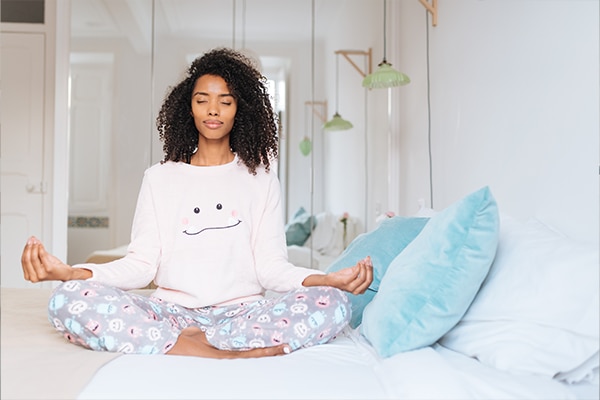20% off €35
What is bedtime yoga?

Most of us know that yoga is a form of exercise that can help us unwind and relax, while also helping us stay fit and healthy.
From Hatha and Ashtanga, to Bikram and Yin, there are lots of different types of yoga out there, all designed to help us find our inner Zen while toning our bodies and taking deep, restorative breaths.
But did you know there’s actually a type of yoga that’s capable of putting you into a yogic slumber?
Keep reading, we reveal all about this fascinating form of bedtime yoga for sleep in this article.
Skip to: Yoga nidra | How does yoga aid sleep? | Yoga routines | FAQs
What is yoga?
What is yoga?
As we mentioned at the start of this article, yoga is a form of exercise; an ancient form of exercise that’s centred around boosting our core strength, flexibility and breathing.
This, in turn, can help improve our overall physical and mental wellbeing.
Yoga involves following a series of postures, all designed to help improve strength, flexibility and breathing.
It’s practised the world over and is believed to have originated from China around 5,000 years ago.1


Yoga nidra, also known as yogic sleep or bedtime yoga, is an incredibly powerful form of meditation and yoga that’s reportedly easy to learn and maintain.
This systematic meditation is usually carried out lying down and involves resting comfortably in the corpse pose (savasana) and then slowly transitioning into the five layers of self-pose (pancha maya kosha).2
During yoga nidra, you are encouraged to focus your attention inwards, which results in you ‘surfing’ between being awake and asleep.
Eventually, your body finds its natural state of equilibrium, your breath balances out and you fall into a deep sleep.3
Summary
- Yoga is an ancient form of exercise designed to help improve strength, flexibility and breathing
- Yoga nidra, also known as yogic sleep or bedtime yoga, is an incredibly powerful form of meditation and yoga
Whichever way you look at it, bedtime yoga for sleep (or yoga nidra) is a type of guided meditation that leads you into such a calm state that’s capable of sending you off to sleep.
So if you want a hand with nodding off, and quite like the idea of trying more relaxing pursuits to enable you to achieve this, then bedtime yoga may be just what you need.
Just one 30-minute session of yoga nidra is reportedly as restful as getting between two and four hours of sleep.4
The fact that yoga nidra translates to ‘yoga sleep’, ‘the sleep that is yoga’ and the ‘yoga of sleep’ is a clear indicator of its correlation with sleep.
In terms of how it works in reality, it helps slow down electrical activity in the brain.
Regular practicing of yoga nidra can channel your brain waves down from a high level of stress to a state of calm and deep sleep, enabling vital repair and restoration to take place in the meantime.5


Bedtime yoga sleep routine
You can do yoga nidra with the aid of a teacher or you can do it on your own in a nice comfy place, ideally your bedroom, so that you can enjoy a peaceful sleep after doing a session.
(Tip: you may want to cover yourself with a blanket because the main aim is for you to feel as comfortable and as warm as possible because you’ll be in the same positions for at least 30 minutes).6
As with all forms of yoga, there are slight variations with the poses, which you will naturally refine yourself the more you get to grips with them and practice them.
Generally speaking, a yoga nidra session involves the following steps.7
Bedtime yoga sleep routine
1
Lie flat on your back or a yoga mat or blanket on the floor and tuck a pillow underneath your head
(Tip: if it’s difficult for you to lie on the floor or you find it uncomfortable, use a recliner or do the session on top of or in your bed).
2
Connect to your deepest desire
Focus on a lifelong goal or something that relates to your health. Visualise reaching this goal and feel the joy that comes with accomplishing it.
3
Set an intention
Think about your main purpose for doing yoga nidra and what you want it to help you achieve.
4
Find your inner resource
This involves tapping into a safe space within the body so you feel secure and at ease.
5
Scan your body
Focus on certain parts or sensations throughout the body. The goal of this is to help reduce tension so you can relax.
6
Pay attention to your breathing
Focus on how air is flowing in and out of your body. Take note of how it comes in your nostrils and how your abdomen rises and falls. It will help you to breathe more slowly and evenly.
7
Welcome your feelings
If you have had a difficult day, embrace it.
8
Witness your thoughts
Similar to step seven, observe your thoughts in the moment without judging or trying to block them out. Where possible, replace any negative thoughts that appear with positive thoughts.
9
Experience joy
If you start to feel blissed out, embrace it and let it wrap around your body.
10
Observe your ‘self’
Be aware of how you might be feeling.
11
Reflect on your practice
Think about how you feel and what you were able to tap into during your session.
If after reading these steps you don’t feel confident enough to give yoga nidra a try just yet, don’t forget you can attend yoga nidra classes, where you can learn the basics and become familiar with the different steps.
If you prefer to try it alone, there are meditation apps and videos online you can follow in the comfort of your own home and at your own pace.
In the meantime, this video from Mind Body Soul, is a useful starting point for understanding what yoga nidra is and what it looks like when you’re doing it.
Summary
- Yoga nidra reportedly helps slow down electrical activity within the brain
- You can practice it with a teacher or you can do it in a comfortable spot at home
- Sessions last anywhere between 10 and 30 minutes


Bedtime yoga FAQs
While yoga is normally associated with lying down on the floor on a yoga mat, yoga nidra is something you can do lying down on your bed.
One of the main things about this form of yoga is that you feel 100% relaxed, and if your bed is the comfiest place for you, there’s no reason why you can’t practice yoga nidra from it.
As with all forms of yoga, the more you practice bedtime yoga, the more natural it feels and easier it is for you to incorporate into your daily routine.
While it’s recommended you do it before bedtime – because it can help you sleep – you can do it any time during the day when you need to relax.8
Timing-wise, you can do yoga nidra at a time that best suits you however, best practice guidance dictates you shouldn’t do it immediately after eating, drinking coffee or exercising, as they can interfere with your ability to switch off.
As a result, some people do bedtime yoga before tea or after work, which tends to mean they schedule it in first or last thing in the day.
To achieve the maximum effect, aim to practice it twice a week, initially for around 10 to 15 minutes at a time, gradually working up to the full 30 minutes.
Absolutely, if you feel comfortable enough doing so. The main thing is that you are lying flat on your back and you find this position comfy.
Rather than lying directly on a hard, cold floor, you may prefer to lie on a yoga mat and prop a pillow under your head, both of which will provide you with some additional comfort.
Yoga is designed to help us relax and unwind, so taking part in it before bedtime is ideal. More specifically, yogi nidra or bedtime yoga, can potentially help you fall into a deeper sleep due to the way it slows our brain waves down and encourages us to focus on our inner self, thoughts and feelings.
Takeaway
Yoga nidra is a fascinating form of meditative yoga that’s used far and wide by people to reach a deeper state of relaxation, ultimately resulting in sleep.
It can be carried out any time of the day however, it’s often practiced before bedtime due to its abilities to enable people to slow their brain and thoughts down and focus on the main task at hand, going to sleep.
Most yoga nidra sessions last for up to 30 minutes, with those who are new to it taking part in 10 to 15 minute sessions, and slowly building up the time as they become more familiar with it.
For more practical guidance on falling asleep, take a look at this article, ‘How to fall asleep faster.’
- https://www.nhs.uk/live-well/exercise/guide-to-yoga/
- https://yogainternational.com/article/view/5-benefits-of-yoga-nidra
- https://www.ekhartyoga.com/articles/practice/what-is-yoga-nidra
- https://www.refinery29.com/en-us/yoga-nidra-sleep-benefits
- https://balance.media/yoga-nidra-works-improve-sleep/#:~:text=Practising%20Yoga%20Nidra%20can%20cycle,vital%20repair%20and%20restoration%20happens.
- https://www.bulletproof.com/sleep/sleep-hacks/yoga-nidra-guided-sleep-meditation/#p4
- https://health.clevelandclinic.org/what-is-yoga-nidra/
- https://www.bustle.com/wellness/yoga-nidra-for-sleep
The advice in this article is for information only and should not replace medical care. Please check with your GP or healthcare professional before trying any supplements, treatments or remedies. Food supplements must not be used as a substitute for a varied and balanced diet and a healthy lifestyle.





